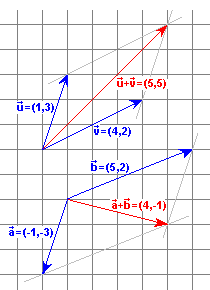|
ACTIVITY 2.3 |
|||
|
If we apply the parallelogram law to make sum of two given vector by his components, we also arrive to the conclusion that components must add the respective ones of each vector. So in the figure we have it sum of the same previous activity vectors
Now made them using the parallelogram law now. Also you check that if |
 |
|
INTERACTIVE ACTIVITY You have the sum now Moving the green points to vary the vectors
You observe also that always it is verified: |
| HOMEWORK |
You make the following sums vectors representing them in a squared paper and using the parallelogram law:
a) (5, 2) + (-2, 4) d) (-3, 3) + (-3, 3) |
b) (-7, 4) + (1, -3) e) (-4, 1) + (4, 5) |
c) (7, -6) + (-4,0) f) (-3, 5) + (3, -5) |
|
END OF ACTIVITY 2.3 |
|||